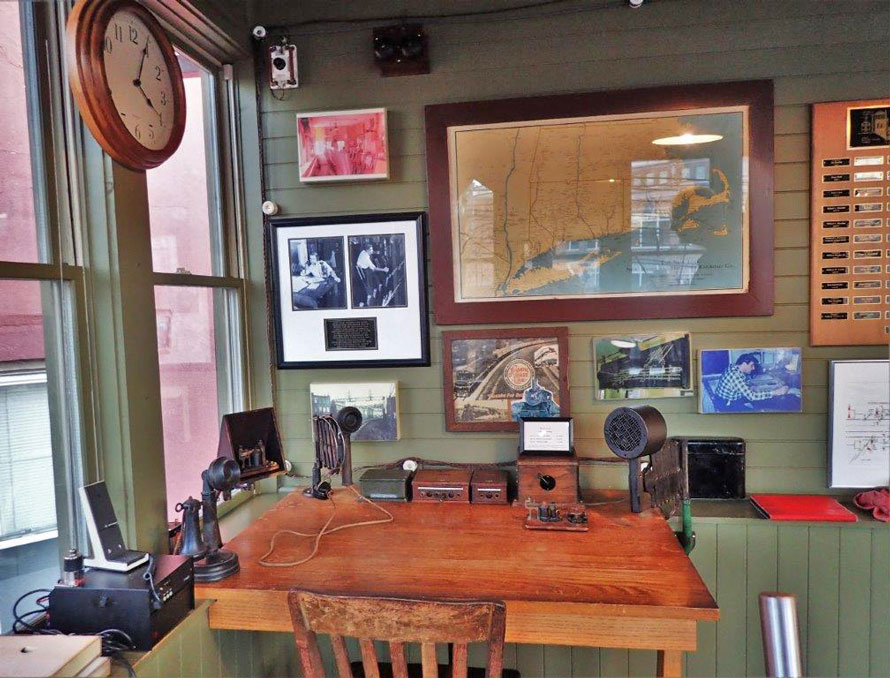
Last fall I shared some ideas with my friend Rick Selva about what I thought was needed at the SONO Switch Tower Museum in South Norwalk, Connecticut. (From this point on I will refer to it as Old Tower 44 like it was called on the New Haven RR. Later on it was called Berk then after it closed and controlled from NYC at the control center, CP 240 & 241.) Rick’s background when he hired out on Conrail was as lineman on the B&A and Maybrook line. His hobby is old communication equipment, and he knows it very well. Rick and I threw around some ideas and I ran them by John Garofalo, who is one of the most dedicated volunteers you could ever meet at the tower. He and his friend Bob Gambling are there almost every weekend from May till October, when we close. Garf, as he likes to be called, was very excited about our ideas and gave us the OK to do it. Rick’s excitement when I told him we could do our project of hooking up the scissor phone and other phones you see in the pictures throughout our three floors was just what I wanted to see and hear. So Rick, Bob Eb and I spent eight hours working to run wires while Rick hooked these antique phones up. His attention to detail was really something to see, even running wire across the back wall to hide a modern-day wire and he used the insulators you see and affixed the wire to it like it was done 100 years ago.
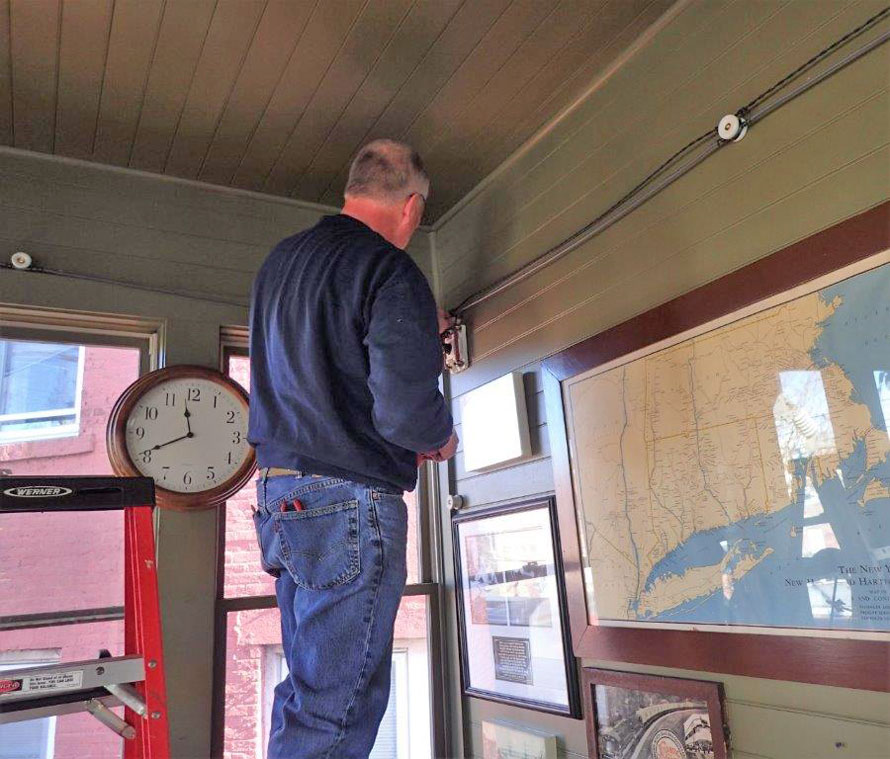
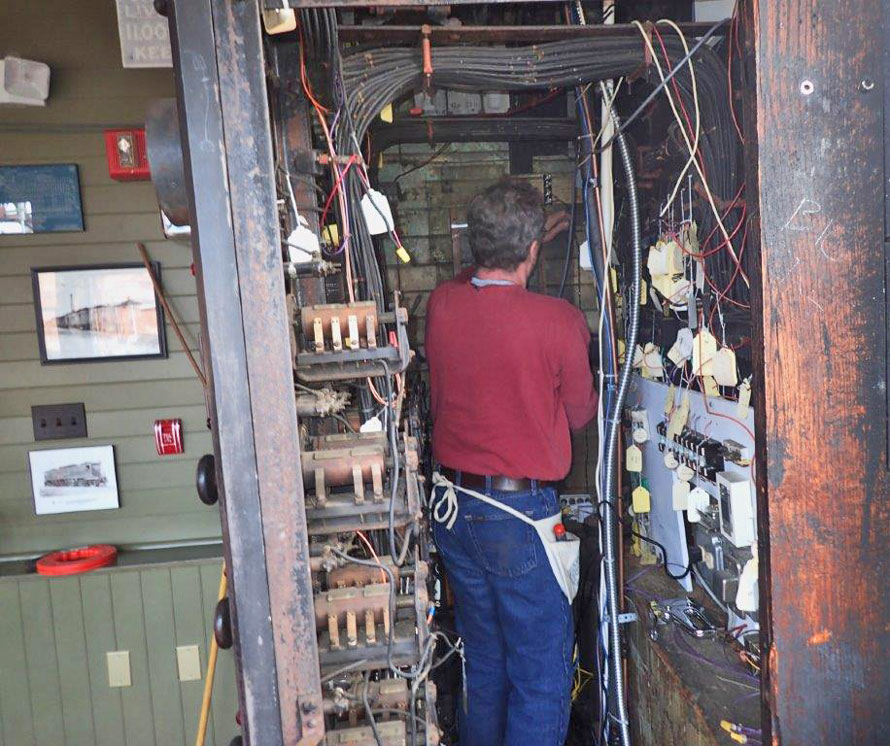
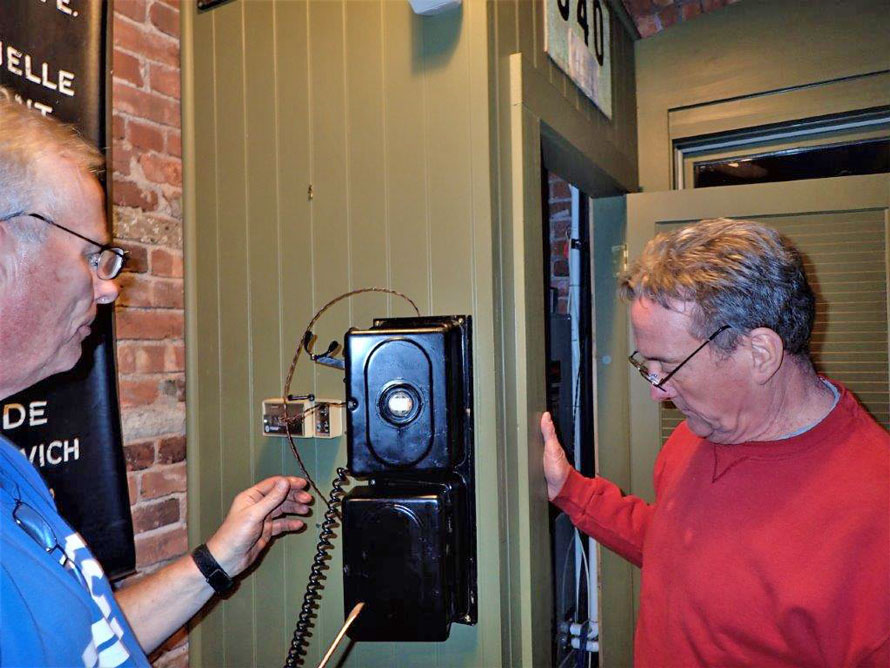
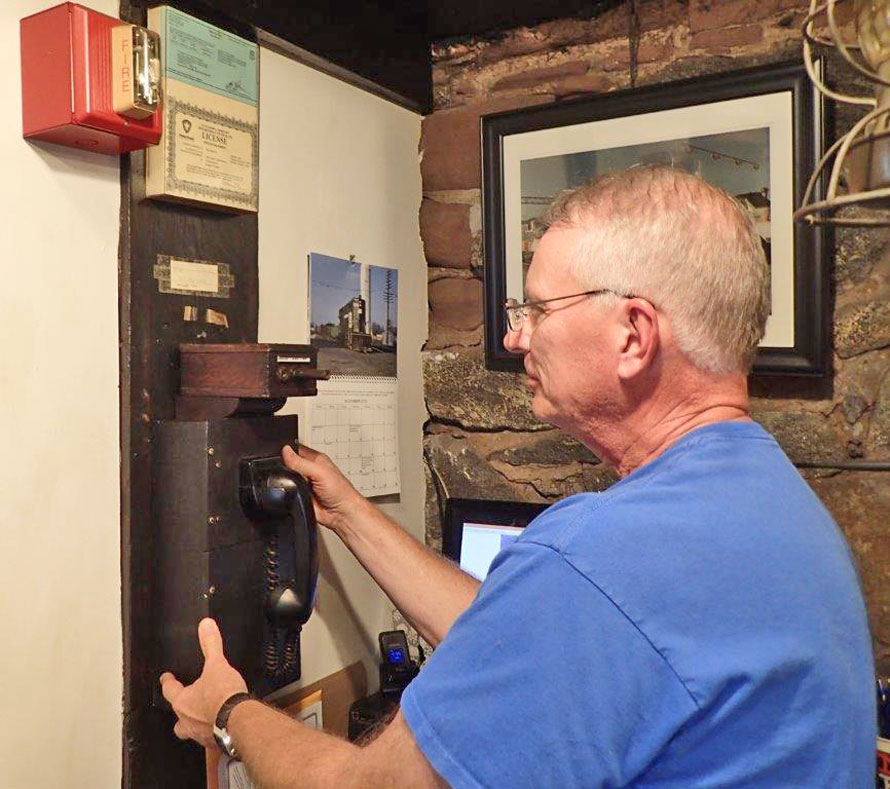
We were lucky Rick had some old equipment as did the tower. Much had to be bought on eBay! On a second Saturday, Rick and I went down and worked all day to do some more and finish the phone project. There was a work session going on during part of one of the days we were there and some other volunteers who we had not met, showed up to help. Their project was to oil the strongarm levers so they do not rust over winter when the building is closed. They stood and watched us while we worked, and I know since they were volunteers much longer than us they were wondering what we were doing.
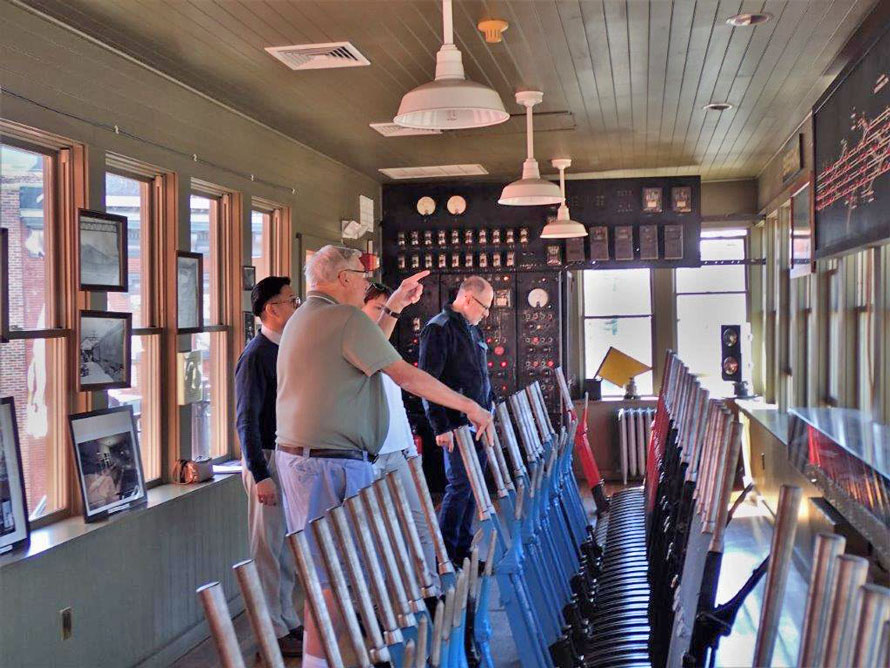
But when we finished up that first day and almost everything worked and some got to try it out we knew they were pleased. John Garofalo worked as an operator years ago in towers on the New Haven; he knew what was there then and what came before but never figured he would have it in Old Tower 44. Look at his face when he was speaking to Rick on the scissor phone. The foot pedal on the floor that is used for this was one of the problems Rick had to figure out, and he did.
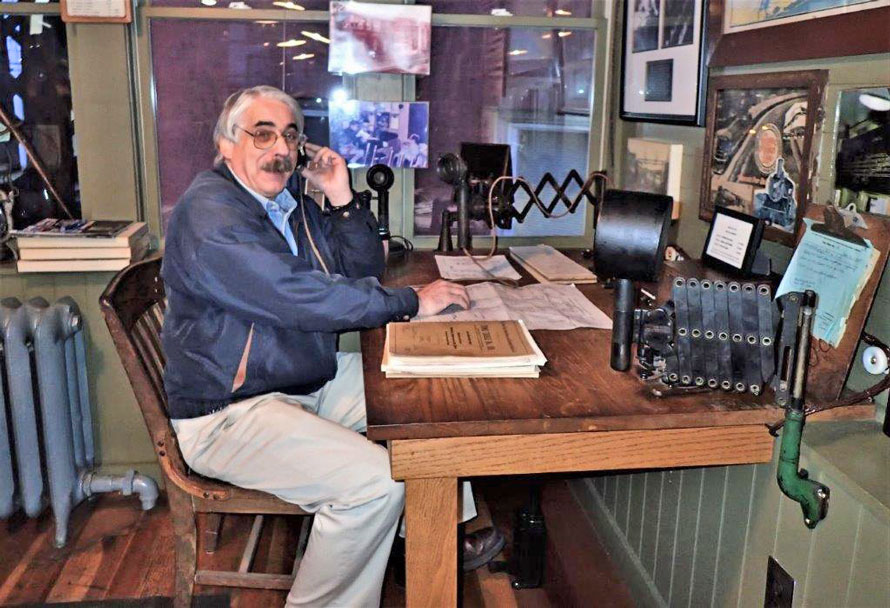
Rick hooking up old crank phones and the dispatcher speaker as well as the foot peddle and scissor phone took us back to pre-1966. The New Haven removed their own telephone system and replaced it with the Centrex Telephone system leased from Ma Bell on March 1, 1966. It was during this time the New Haven went from scissor phones in towers and crank phones along the right of way to dial phones for communication.
Our next step was to go back to the beginning before phones when the only means of communication was telegraph.
I found out there are not many people that know Morse code and they are getting fewer. They really are the last of a dying breed.
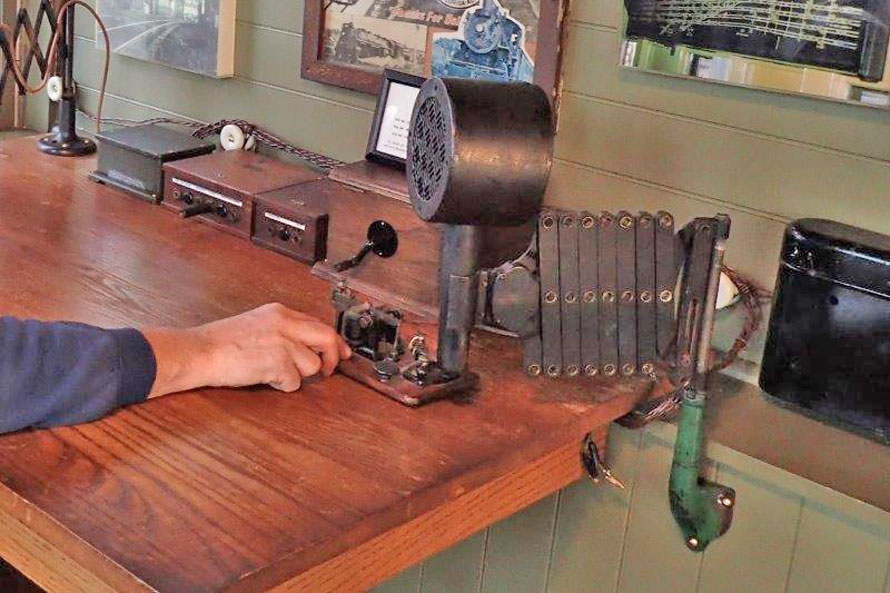
We had a key and sounder that were hooked together to make the sounder click and clack. That was easy but we wanted to be able to send Morse Code to someone, preferably someone with railroad background or knowledge. That took a lot of time and digging on the internet, with many dead ends. You can find people that are Ham Radio operators who know international code. This code is very different from the Morse code used by the railroads. Soon I found out there are not many people that know Morse code and they are getting fewer. They really are last of a dying breed.
Another retired railroader I know, Art Dowd, sent me some information on Harris Tower in Harrisburg, Pennsylvania. This tower, like Old Tower 44 is a museum now. Abram Burnett is a volunteer docent at this tower and not only knows American Morse code but sends out messages on a key in that tower on Saturday’s when it is open. He also can do it from home. He shared some pictures of his beautiful collection of antique telegraph equipment. He has it going all day while he is home to listen to other telegraph key operators and also a dispatcher’s wire that through modern technology you know when trains are by CP points out west. This all happens through the internet now.
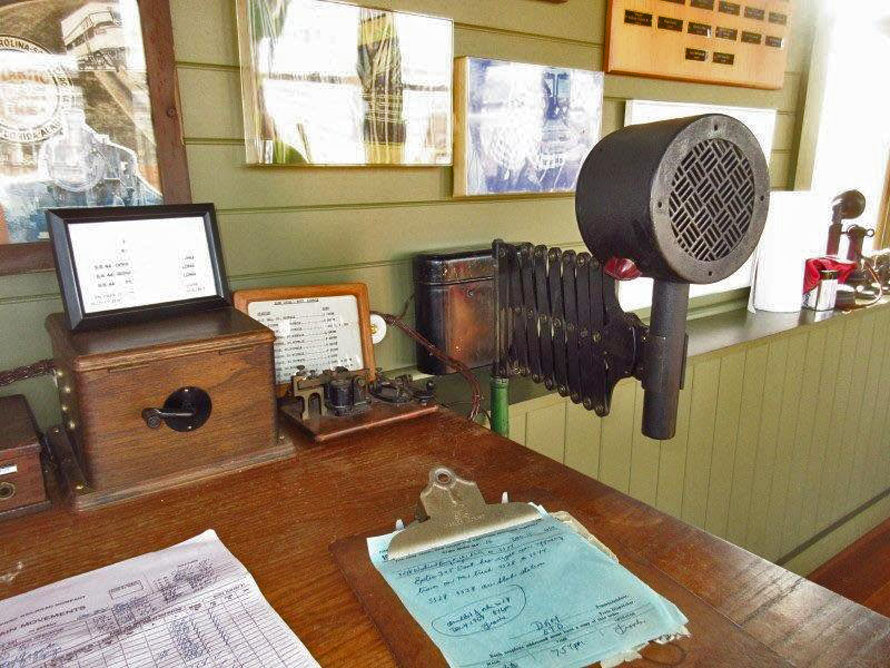
I’ll explain in a bit. From what I have seen in pictures from newsletters put out by the Morse Telegraph Club (MTC) http://www.morsekob.org/ these people take this very seriously. When they do demonstrations they have a dress code for it. There is a black sleeve they wear like long ago so the sleeve on their shirts up to the elbow does not wear out or get dirty along with a black bow tie. A visor is worn to protect their eyes (back in the day they did not have soft white bulbs over the desks) from overhead lights. I kept digging and found the MTC and contacted a board member at the Antique Wireless Association museum in upstate NY. Bob Hobday, who knows International Morse Code but not American, said it would be best to contact Chris Hausler as he knew American Code. I took his advice and Chris has been a tremendous help to me on this project. As luck would have it, Chris knew about railroads as he worked for a company that made the electric components that would run the hump in Selkirk New York. We never crossed paths but I was going to Selkirk yard for many years and knew the hump classification yard well. Google played a big part in my research for all of this also. Through Chris and Abram I learned about Les Kerr. Over ten years ago, Les created a program that we all use today MorseKOB. With his program, anyone, anywhere, with an internet connection can go on-line and download his free program and send Morse code on your key board. The MorseKOB program https://sites.google.com/site/morsekob/morsekob25 will make the clicks and clacks of the telegraph sounder using the computer’s sound system and you can use a key on the keyboard as a telegraph key. The right arrow key can be either a straight key or the dash paddle of a bug; the left arrow is the dot paddle and will make a sequence of dots as long as you hold it down. You can also just type what you want to send on the keyboard and it will generate the code for you! With a relatively simple interface it is possible to connect real telegraph instruments to your computer and the program will use them instead. Connecting just a key and using the computer’s sound system is trivial. Connecting a sounder is somewhat more involved as the serial interface on a computer, either a classic serial port or a USB port, doesn’t provide enough power to drive a sounder. However, you can either build a simple transistor amplifier circuit to drive the sounder or Morse Telegraph Club member Chip Morgan manufactures and sells a “loop interface”, either a USB or serial port version, which will greatly simplify the necessary effort. It is available from https://www.meceweb.com/interface-ordering.html .
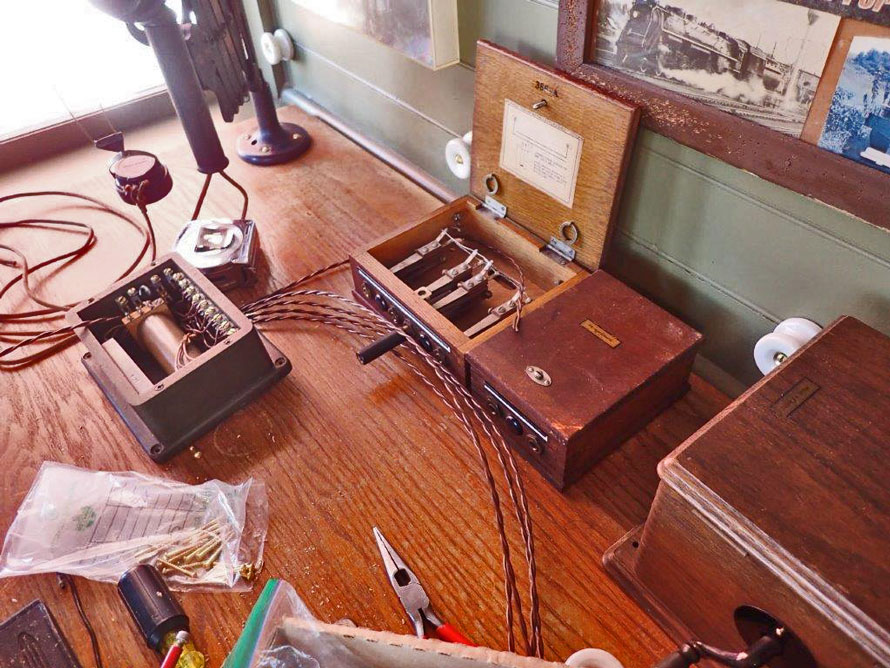
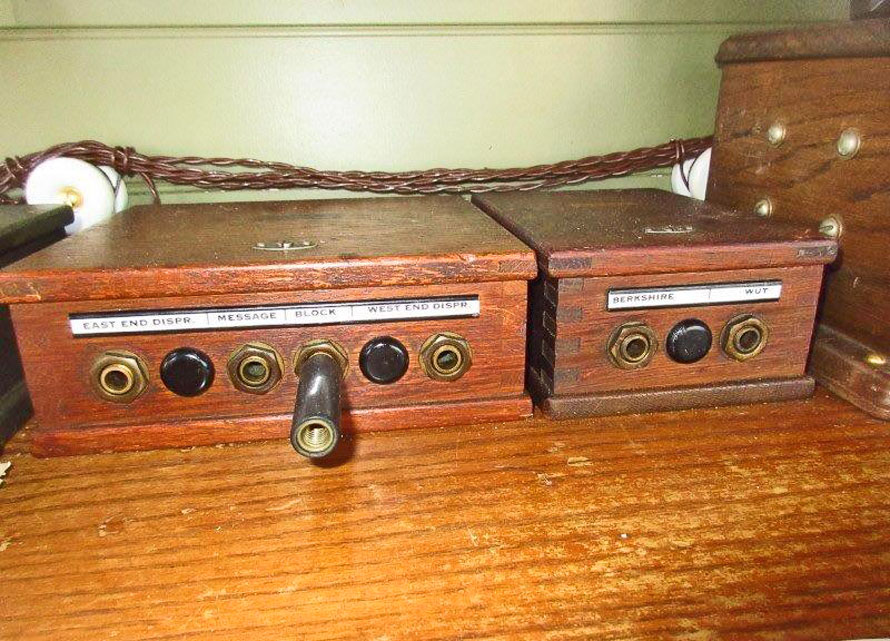
Rick has Chip’s little box hooked up in an old oak jack box like the ones you see on the desk already so it will match perfectly. Everything on the desk in the tower will look as it did over 100 years ago when Rick is able to get to the tower to hook up the last piece of equipment. (Due to the virus it did not get hooked up yet.)
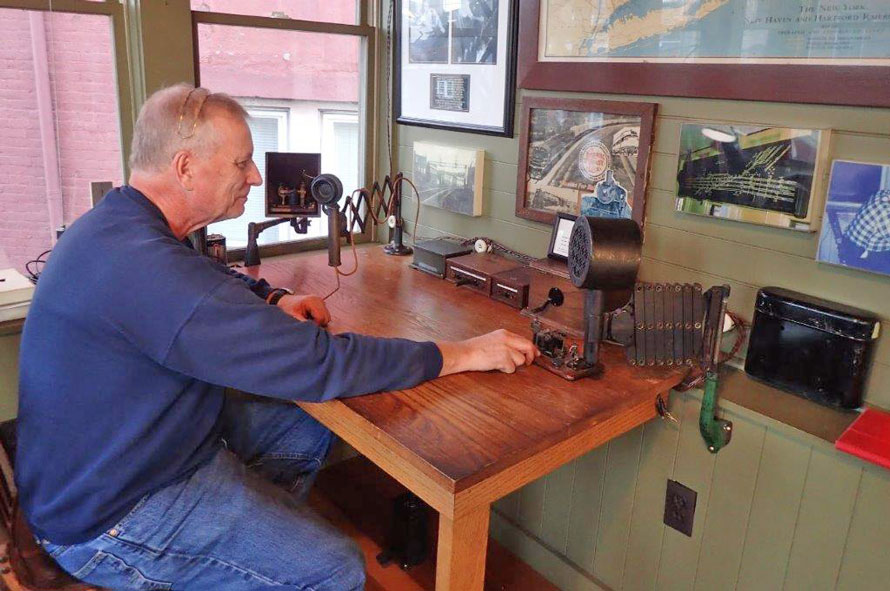
With everything we have done it will be great if we can do demonstrations for the public. We need a few people that know Morse Code to help us send out the information from the tower like they did almost 100 years ago. After you download the program Les came up with at this site http://mtc-kob.dyndns.org/ you can see what wires are taken, many run around the clock, with code being sent over them. This is where Chris and some others come on the wire on Saturday at 2 PM eastern time and chat. They use this time to stay sharp on using a key, not necessarily to talk about railroads. But one Saturday I went on to see what was going on in case someone was talking about railroads and I met Don Reser. As luck would have it Don was a boomer on several railroads in the midwest and worked as an operator. He knew exactly what I was looking for to make up a script for our tower that would be on the wire for people to see and hear. We had a train sheet from December 4, 1968, the last month of the New Haven Railroad. By studying Don’s sheet showing towers and the conversations between the dispatcher and them, I was able to put together my script for the tower. It can be listened to on wire 131 (when I am on). There are many abbreviations that were used back in the day that I didn’t know and Don, through many emails, explained everything to me.
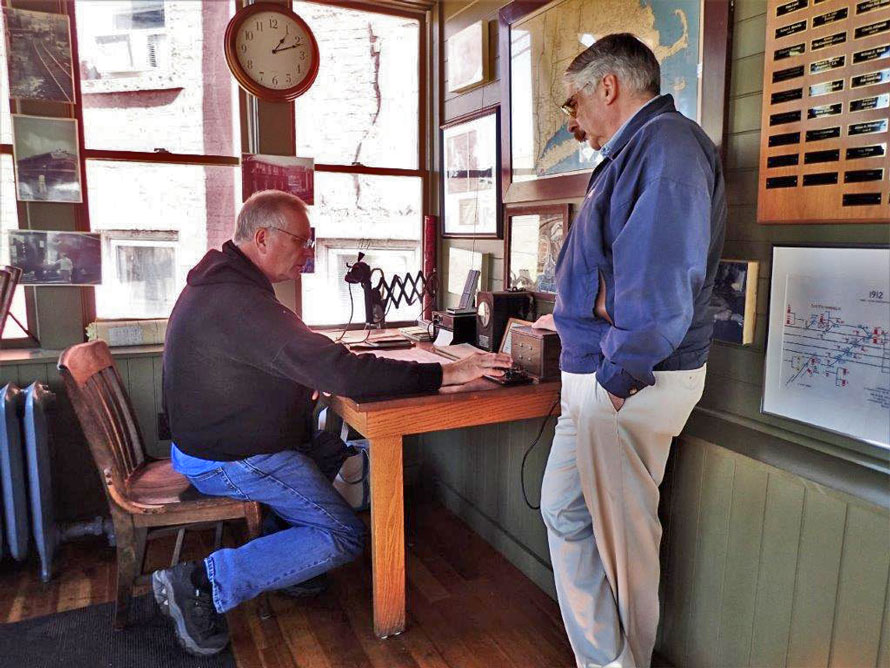
The newsletter that the Morse Telegraph Club puts out, is about twenty-five pages long and if you like railroad history, it’s filled with stories, very well written stories I might add, that talk about telegraphers, towers, train stations and most importantly, people and how they used the Morse code to move trains. Chris also has a column each issue on books he has read, mostly out of print books that pertain to this. For about $24, I got three of them myself and over winter read them. One pertains to operators that lived over, next to or in a house next to the stations. I knew of this but never had any idea how many railroads did this throughout the country. Another book is about Montana that was published several years ago. Sadly many people that used the code are in their 90’s and I don’t think anyone young is coming along to learn how to do this. I know this because of the stories in the newsletter I learned that Canada kept Morse Code going longer than here, that conclusion I came to because many of the stories are written by Canadian retired railroad people. Lots of railroad history here for a few bucks a year. Without more members, even if they do not learn the code, the cost of keeping the club going and putting out a well written newsletter will become too much and this will become a blip in history. Morse Telegraph Club would welcome new members. Here is a link to their website http://www.morsetelegraphclub.com
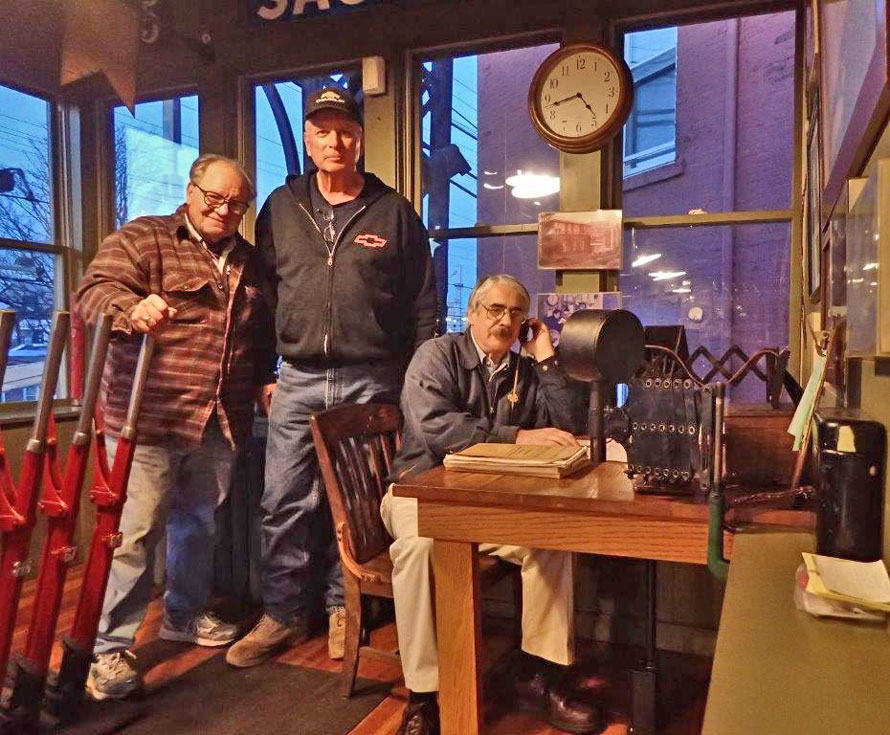
I hope you have enjoyed this story about a very real and important part of railroad history. And I want to thank all those people I have mentioned that answered my questions. Without their help, this important part of railroad history that we have recreated at Old Tower 44 would not happen. By the way, the call letters for tower 44 were SH so if you happen to be on the wire this season you will be able to find us. Saturday, April 25, 2020 is Morse Code Day, celebrating Samuel F.B. Morse’s birthday. Due to the virus this year there will be no public get-togethers, but if you look at this site you may be able to see a virtual get together and also there are pictures from when they have done it in the past.
John Springer – Photographs and text Copyright 2020
Note: In recognition of Morse Code Day, this article replaces John's story, Going to Maybrook which was scheduled to appear this week. Going to Maybrook will publish in June.
Superb story!
Thank you glad you enjoyed it
Worked with Rick on Amtrak (and I was at Sweeney building in Springfield, Ma when he hired out in CR signal dept in 1976, though I didn’t know him at time).
And you couldn’t ask for a nicer, attentive guy to the operating rules when you worked with Rick. So it is no surprise to read about his work at Berk Tower.
JIM I told him to check your your comment. He is very attentive guy, he left out no detail.
Thanks John. I also read your article on OW Tower a few months back. I used to visit the towerman at OW when I worked SETT-TTSE and was waiting for traffic to clear so we could double empties from GM plant to our caboose and have towerman line up our route back to Selkirk.
My five years in the New Haven and Penn Central towers were from 1965 to 1970. This type of communication equipment was used until about 1968 when replaced by a new dial system. There were many lines and plug receptacles in towers like SS 22, 38 and 44. Each line had a different bell/sound and we had to learn how to differentiate them. And the towers had their own call that could vary by line. For instance, on the block line to the west, SS44 might have been two shorts, Darien Station might have been three shorts, SS38 might have been two shorts followed by a long, etc. It took me longer to learn the phone lines, tones and codes than it took me to learn the interlocking machines.
Thanks for writing Steve, I look forward to meeting you sometime when we open
I’ve passed by that building my whole life and just took it for granted. This
restoration is fascinating and so meticulous. I hope I can see the inside some day.
As a rule Nancy they open it next month but with the virus you can check the Facebook page for the tower or the web site. Perhaps I’ll be there when you visit.
I hired out on the New Haven in November 1956 and got Qualified in all towers between New Rochelle
SS 22 and SS75 New Haven. I went to school in Milford Ct and would go to all the towers in the area ,SS60,SS71,SS73 Woodmont, SS75,SS78 Fair St,SS79 Mill River jct, SS80,Air line Jct SS81,Shore line Jct. I bid in the relief job between Stamford SS38 and South Norwalk SS44 and worked it until. I went into ticket agent service followed by Yardmaster at Stamford Yard and the promoted to Asst trainmaster at GCT. Transfered to New Jersey Division in 1978 and work Bayway, Weehawken,Croxton, and Eport Dispatchers office Supervisor untill 1984. Railroading was a different experience then than now. Oh for the GOOD OLDE DAYS
There was NEVER any MA BELL in CT except Greenwich CT that was served by NY BELL. The telco in the rest of CT [except Woodbury] was SNET Southern New England Telephone Company. AT&T’s stake was only 19.6 percent and SNET was NOT considered a Bell Operating Company; rather, considered an independent phone company. After some later corp. changes, what was once SNET is now owned by Frontier .
Could you please provide a picture of a operator with his visor, bow tie, white shirt with black sleeves. I want to try to get a model maker to make an HO figure of same.
Ben, I wrote to Abe and am waiting to hear back from him about sending his picture
Before the Penn-Central take over and the renaming of towers and drawbridges on the New Haven, I worked towers Devon, Central Avenue, Bridgeport 60 drawbridge, Burr Road, and Greenwich. Left the New Haven in July 1968, working for Erie-Lackawanna from Port Jervis NY working in towers and stations. I liked the old telephone system and was sorry to see it replaced by the new bell phones! But I did get a number of the old phones before they went to the dump, which I ultimately donated to the Railroad Museum of New England at Thomaston CT. Glad I saved them! They were all well made and the oak jack, phone and ringer boxes were nice crafted beauty! Also retrieved a couple of sounders, like we used to communicated with Devon Draw from the tower. I didn’t work at “Snowalk”, but visited some of my operator friends there. New Haven RR Towers was a great and memorable experience!
Walter,
I just saw this. Thank you for writing. I ran trains at the RMNE for 6 years, Rick volunteered up there for a while also. It’s great you donated those things to them, to bad they don’t have a museum where people can see them in operation. You left 2 years before I hired out. Did you take any pictures while you were working those towers? Would love to see them.
John
John,
I did take some photo’s of the towers and the towermen, but unfortunately with only a brownie camera as I wasn’t much into photography. And second error was not annotating the photo’s as to the operators depicted therein! Couple years ago, I sent a bunch of the “better” ones to Steve McEvoy for background on his book. I would have to find the book and those photo’s. Wish I had captioned those photo’s then, because while I recognize the faces now, many of their names have escaped me! I have learned a hard lesson from that error — now I mark-up everything! My email address is waltstapleton@comcast.net. Let me have your preferred postal mailing address and I’ll see if I can find those photo’s to send you. They won’t be of any publishable quality, but you might enjoy looking at them!
Best wishes,
Walt